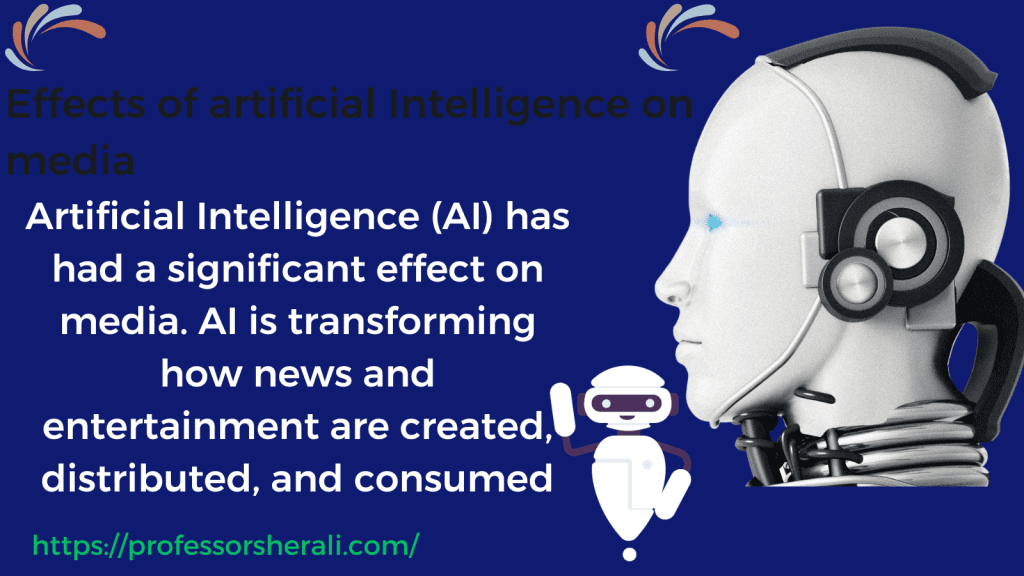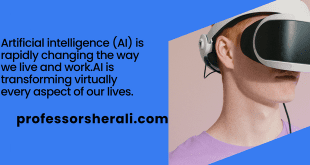0
Artificial Intelligence (AI) has had a significant effect on media. AI is transforming how news and entertainment are created, distributed, and consumed. In this article, we will explore the effects of Artificial Intelligence on media, focusing on key areas such as automated journalism, personalized content, content moderation, and audience analytics.
Automated Journalism: Improving Speed and Accuracy
Automated journalism, also known as algorithmic journalism, is a rapidly growing trend in newsrooms. AI is used to generate news articles, freeing up reporters to work on more complex stories. AI-powered news articles are more accurate, as they rely on data rather than subjective interpretation. This has enabled news organizations to produce news articles quickly and efficiently. Automated journalism is especially useful for producing financial and sports reports.
However, the use of AI in journalism raises ethical concerns. Some critics argue that the lack of human involvement in the news-making process can lead to biased or incomplete reporting. Others argue that AI-generated news articles lack the creativity and insight of human-written stories.
Personalized Content: Tailored to User Preferences
We use to create personalized content for media consumers. By analyzing user data, AI algorithms can create customized newsfeeds, recommend TV shows and movies, and even generate music playlists. Personalized content is becoming increasingly popular as consumers seek tailored experiences that cater to their interests and preferences.
However, personalized content raises privacy concerns. The collection and analysis of user data cause disruption, and there is a risk that AI algorithms can be used to manipulate consumer behavior. Moreover, personalized content can reinforce existing biases and limit exposure to diverse perspectives.
Content Moderation: Enforcing Community Standards
AI is being used to moderate content on social media platforms. With the vast amount of user-generated content being shared on social media, it is impossible for human moderators to review every post. AI algorithms can analyze user-generated content, flagging posts that violate community standards or contain hate speech.
However, content moderation by AI is not without its challenges. AI algorithms can struggle to distinguish between hate speech and legitimate speech, leading to false positives and false negatives. Moreover, the use of AI for content moderation raises concerns about the potential for censorship and the impact on free speech.
Audience Analytics: Understanding User Behavior
AI is being used to analyze audience behavior and preferences. By tracking user engagement, AI algorithms can provide insights into how audiences consume media. This data can be used to inform content creation, distribution, and marketing strategies. Audience analytics help media companies to understand their audiences better, resulting in more targeted content and better user experiences.
However, the use of audience analytics raises privacy concerns. The collection and analysis of user data can be intrusive, and there is a risk that user data can be misused or shared without consent. Moreover, the reliance on data-driven insights can lead to a focus on quantity over quality, leading to a decline in the overall quality of media content.
Video Production: Enhancing Visual Content
AI is being used to enhance the production of video content. AI algorithms can analyze video footage and automate tasks such as video editing, color grading, and motion graphics. This makes video production more efficient and cost-effective, as it reduces the need for manual labor. Moreover, AI can create realistic deep fake videos for entertainment and marketing purposes.
However, the use of deep fake videos raises concerns about the potential for misinformation and manipulation. There is a risk that deep fake videos can be used to spread false information and deceive audiences. Additionally, the reliance on AI for video production may lead to a lack of creativity and originality, resulting in generic and formulaic content.
Voice Assistants: Transforming Audio Content
AI-powered voice assistants such as Amazon’s Alexa and Google Assistant are transforming audio content. Voice assistants can play music, read the news, and provide personalized recommendations. Moreover, they can understand natural language and respond to user requests, making them an increasingly popular tool for media consumption.
However, the use of voice assistants raises privacy concerns. Voice assistants are always listening, and there is a risk that they can be used to collect sensitive user data. Additionally, voice assistants can reinforce existing biases and limit exposure to diverse perspectives.
Content Creation: Enabling New Forms of Creativity
AI is enabling new forms of creativity in media production. AI algorithms can generate art, music, and even screenplays. This has the potential to transform the creative industries, enabling new voices and perspectives to emerge.
However, the use of AI for content creation raises ethical concerns. Some critics argue that AI-generated content lacks the emotional depth and human insight of human-created content. Moreover, there is a risk that AI-generated content can be used to replace human creators, leading to job losses and a decline in the quality of creative output.
Advertising: Improving Targeting and Efficiency
AI is being used to improve the targeting and efficiency of advertising. By analyzing user data, AI algorithms can identify the most relevant and receptive audiences for advertising messages. This results in more effective and cost-efficient advertising campaigns.
However, the use of AI in advertising raises concerns about privacy and manipulation. Advertisers can use AI to track user behavior and collect data on their preferences and interests. Moreover, there is a risk that AI-powered advertising can be used to manipulate consumer behavior and reinforce existing biases.
Video Production: Enhancing Visual Content
AI enhance the production of video content. AI algorithms can analyze video footage and automate tasks such as video editing, color grading, and motion graphics. This makes video production more efficient and cost-effective, as it reduces the need for manual labor. Moreover, AI can create realistic deep fake videos that can be used for entertainment and marketing purposes.
However, the use of deep fake videos raises concerns about the potential for misinformation and manipulation. There is a risk that deep fake videos spread false information and deceive audiences. Additionally, the reliance on AI for video production may lead to a lack of creativity and originality, resulting in generic and formulaic content.
Voice Assistants: Transforming Audio Content
AI-powered voice assistants such as Amazon’s Alexa and Google Assistant are transforming audio content. Voice assistants can play music, read the news, and provide personalized recommendations. Moreover, they can understand natural language and respond to user requests, making them an increasingly popular tool for media consumption.
However, the use of voice assistants raises privacy concerns. Voice assistants are always listening, and there is a risk that they use to collect sensitive user data. Additionally, voice assistants can reinforce existing biases and limit exposure to diverse perspectives.
Content Creation: Enabling New Forms of Creativity
AI is enabling new forms of creativity in media production. AI algorithms can generate art, music, and even screenplays. This has the potential to transform the creative industries, enabling new voices and perspectives to emerge.
However, the use of AI for content creation raises ethical concerns. Some critics argue that AI-generated content lacks the emotional depth and human insight of human-created content. Moreover, there is a risk that AI-generate content to replace human creators, leading to job losses and a decline in the quality of creative output.
Advertising: Improving Targeting and Efficiency
We use AI to improve the targeting and efficiency of advertising. By analyzing user data, AI algorithms can identify the most relevant and receptive audiences for advertising messages. This results in more effective and cost-efficient advertising campaigns.
However, the use of AI in advertising raises concerns about privacy and manipulation. Advertisers can use AI to track user behavior and collect data on their preferences and interests. Moreover, there is a risk that AI-powered advertising can be used to manipulate consumer behavior and reinforce existing biases.
Conclusion
In conclusion, AI is transforming the media industry in numerous ways, from automated journalism to personalized content, video production, and content creation. AI is also impacting advertising and voice assistants, creating new opportunities for media companies and consumers alike. However, the use of AI also raises ethical concerns related to privacy, bias, and the potential for manipulation. It is essential that media organizations and regulators address these concerns to ensure that AI is used responsibly and ethically. The media industry must find a balance between the benefits of AI and the potential risks, in order to provide users with high-quality content while respecting their privacy and rights.

 Professor Sher Ali My site
Professor Sher Ali My site


